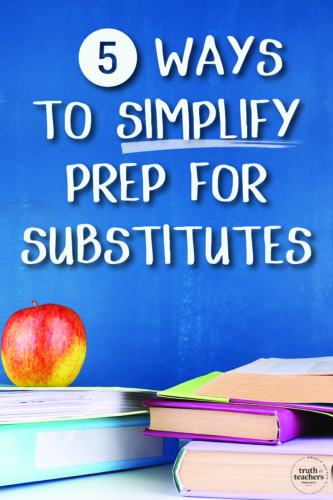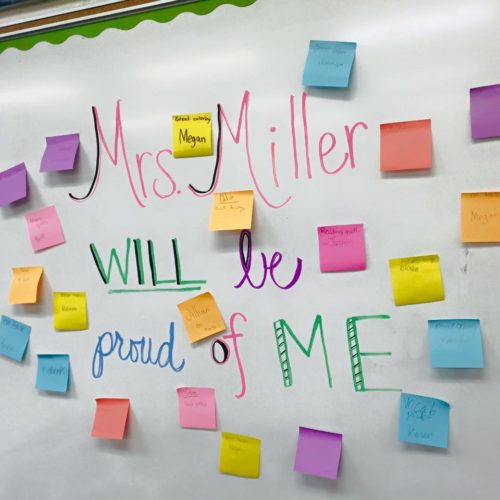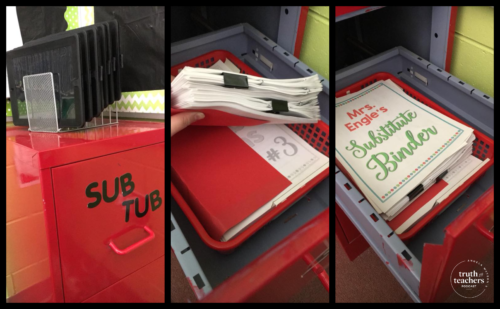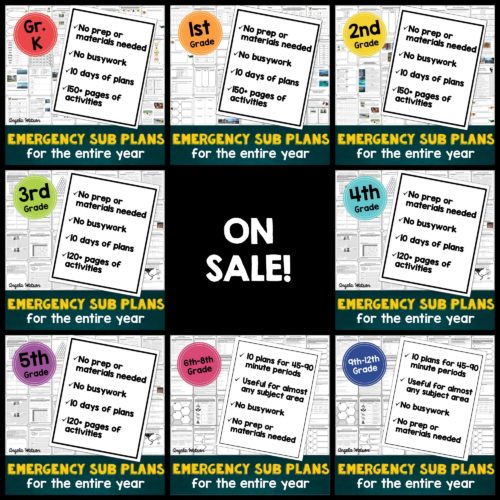This week on the Truth for Teachers podcast, I’ll share 5 ways to make life easier for your substitute and you during an absence, and let you know where to find ready-to-use sub plans that are engaging and rigorous.
A few months ago, I asked members of the 40 Hour Teacher Workweek Club what new printables I could make for them which would help them feel less stressed and overwhelmed. There was one answer I got more often than any other, particularly from the elementary teachers, and that is, a set of emergency sub plans.
I don’t need to tell you how many teachers feel like it’s less work to go into school sick than to write plans for a sub. If I wasn’t contagious, I showed up to my classroom every day, because planning lessons for six subject areas and prepping/organizing all the materials was a massive job. Not to mention, I’d come back after an absence to see our beautifully organized classroom looking like a tornado tore through, and be faced with a complex web of reported behavioral issues and interpersonal disputes between students that I now needed to deal with.
Depending on my class in any given year, it was sometimes really hard to fully relax or disconnect from what was happening in the classroom during a sick day, and I know I’m not alone in that. I’ve heard from teachers who will Skype with their classes multiple times a day when they’re out in order to keep things on track. They say moms and dads never get a day off, and I feel like it’s the same for teachers: If your students are in the classroom that day, you still feel a bit of responsibility for what’s happening, even when you’re not there.
So what’s the solution?
Unexpected absences aren’t really unexpected: We know they’re going to happen from time to time. So even though you don’t know when, you can still do the bulk of your preparation in advance, and set up your expectations and routines to make things go more smoothly. Here are 5 tips to help.

Want to listen instead of read?
Listen to episode 138 below,
or subscribe in your podcast app.
1. Adjust routines so the sub is not trying to run the classroom exactly like you do.
Creating a simplified version of your daily routines and procedures for subs can save you a lot of headaches later on. Teach students that when you are out, someone different will be in charge, and that means your daily routines will be slightly different. Explain, in advance, what they should expect with a sub and why.
For example, you might not want to have kids go to centers when there’s a sub because it can create a lot of mess and noise, and you prefer to be in the room when the materials are being used. So instead, let kids know they’ll skip that part of the reading group rotation and continue doing independent work instead.
Or maybe you don’t want to have subs review homework because you need to be there to re-teach and address misconceptions, so tell kids that and let them know when you’re out, the sub will move immediately from the warm-up to a learning activity. If you do flexible seating in your class, let kids know that they’ll stay at their “home base” area for the day when a sub is there so they’re in one spot and the sub can more easily manage the classroom and get to know students’ names.
Some kids in your class really won’t care, but those who love structure and advanced preparation will hang onto every word and will remind the rest of the class (as well as the sub) about the routines when you’re not there.
Creating a clear structure for sub days — which is unapologetically different from the structure when you’re there — will keep students from constantly comparing the sub to you, and saying things like, “That’s not how we do it! Our teacher doesn’t do it that way!”
It will also keep you from feeling like you need to micromanage the sub and leave insanely detailed instructions for every moment of the day. Giving yourself permission to let go of control and allow for different routines in your absence will free your sub to be more effective and authentic.
S/he cannot be your clone, and when that pressure is removed, the sub can bring his or her own ideas to the classroom (which are often better than what you would have planned because they’re authentic to his/her unique personality and teaching style).
So, embrace the fact that the sub is not you and the day will flow differently with someone else in charge, and help kids prepare for that fact, as well.
2. Adjust expectations so the kids aren’t expected to behave exactly as they do when you’re there.
Expecting kids to act the same way with a sub is a bit like expecting them to act the same way with grandma as they do with mom. Kids act differently with their coaches, with their friends’ parents, with each individual teacher, and so on. When there are different people in charge, that means a different rapport, different attitudes, different expectations, and so on. Kids are not robots who can be trained to behave the exact same way under any circumstance and under any type of leadership.
Also, the best approaches to classroom management hinge on your rapport with students and the relationships you’ve built. Therefore, it makes sense that management falls apart a bit in your absence. Relationships aren’t interchangeable: A sub can’t just walk in your classroom and within the first half hour, command the same level of know, like, and trust as you’ve built over the course of an entire school year.
Remembering this will prevent you from getting frustrated with how subs try to establish authority or how students respond to those attempts: It’s a difficult task for everyone involved.
You can leverage the rapport that you have with your class by discussing expectations for behavior with subs and having students sign a contract. The sub can then review the contract with the class so the kids know you and the sub are on the same page.
You can make it a bit easier by creating a special positive behavior management system that’s only in place for subs in order to give the sub a bit more leverage with the kids. This will also help your sub develop better relationships with the kids by focusing on the positive instead of just tracking misbehaviors.
See if you can suggest a plan that gives students something fun and different to work toward.
Class points or team points are a really easy idea: The sub keeps a running tally of positive choices and good decisions made by students, and if the class gets to a set number of points by the end of the class period or day, they get a few minutes of free time.
Another idea if you teach elementary is to write on the board, “We’re proud of our choices today,” and have kids write their accomplishments underneath (or on sticky notes). When you return to class, you’ll see a list of things kids did well, such as helping out, reading silently, being kind to others, and so on, and you can start the day off on a positive note by congratulating kids on their success. I’ve known dozens of teachers who have tried this and swear it’s one of the most effective things they’ve had subs do, maybe because kids are looking at the display all day long and it reminds them to make good choices.

If you return to class and get a bad report from the sub, my advice is to take it with a grain of salt. You weren’t there, you don’t know what really happened, you don’t know what the sub did to escalate or de-escalate a situation, and it’s essentially the sub’s word against the kids’ word. Personally, I refuse to take responsibility for issuing consequences for student behavior when I wasn’t present. The amount of class time and energy I’d need to spend trying to figure out the whole story and get to the bottom of what happened generally wasn’t worth it unless the behavioral issues were extreme.
My approach was generally to have a class meeting about how things went and/or talk to individual students. I’d say, “I heard that there was a problem yesterday. Can you tell me your side of the story?” and then just listen and nod. I’d ask follow-up questions like, “What could you have done differently to prevent that from happening? What is your plan for next time when there is a problem and a sub is here?” and just sort of talk kids through some problem-solving. I’d reiterate my expectations for how students should behave when I was out. Sometimes I’d have them write apology letters or do some other act of restoration if there was an obvious follow-up response needed by students, but that’s the end of it.
3. Leave a slideshow, video, or audio recording for your students so they understand why you’re not there, and how the day will flow for them.
We all know that “deer in headlights” face kids make when they walk into the classroom expecting an ordinary day but don’t see the usual people or set up. It seems like a small thing to us — what difference does it make if someone else teaches for a day? — but let’s consider for a moment the impact on kids, because that can help us get to the root of behavioral issues they often exhibit with subs.
Walking into class and unexpectedly seeing a substitute can be a traumatic experience for some kids who have really connected with you and feel a sense of abandonment when you’re not there. Other kids may feel insecure because they don’t know what the expectations are or how to be successful. Some might have had bad experiences with subs in the past which predispose them to feel fearful, angry, or rebellious. Others won’t see the sub as an authority figure because she hasn’t earned that yet, and will essentially create their own rules about how to behave in your absence.
As a podcaster listener, you already know how well audio creates a sense of intimacy: You feel much more connected to the person you hear than if you were just reading something they’d written. So, a really simple and easy way to set kids up for success is to leave them a personalized message via video or audio.
You might tell them:
- Why you’re out, if you’re comfortable with sharing that: “Hi, everyone, I’m so sorry I’m not there with you today. My son is sick and I need to look after him, but I’m going to be back with you again tomorrow.”
- Outline the plan for the day so kids know what will be the same and what will be different: “You’ll be doing your regular reading group routines, but we’ll skip the fluency partner practice. The sub knows to take you to the assembly, so don’t worry, you won’t miss it.”
- Set precise expectations and give accountability: “I’m counting on you to complete your projects so that we can begin presentations as soon as I’m back. I also need you to be responsible for cleaning up after the lab so the equipment is where it belongs, and I’ll be checking with team captains tomorrow to make sure that was done correctly.”
- Offer a message of encouragement: “I can’t wait to see you again tomorrow, and see how far you got with your group collaboration while I was gone. Have a great day of learning — see you soon!”
It could be a simple 30-second selfie video on your phone, or if you just want audio, use the built-in voice recorder app on your phone or a free tool on desktop called SpeakPipe. These tools will allow you to record yourself speaking just as easily as leaving a voicemail message.
When you’re done, select “save as” and you can then put the video or audio file in a location for the sub to access it, such as in Dropbox, Google Drive, or your school’s learning management system. If your sub won’t have access to tech in your classroom, try sharing it directly with students through your LMS or with one particular student or colleague who has a device and can play the recording for the class.
You can also drag and drop the audio or video into a PowerPoint or Google Slide which you’ve left for the sub to share with your class. This slideshow can be a fairly generic one which just outlines your daily routines (i.e. 8:00-8:15 bell work, 8:15-9:00 reading, etc.). The sub can display the slideshow throughout the day or class period to keep everyone on track.
Or, you can include more detail on the slides to add important reminders, such as “2:45 Prepare for dismissal. Take home permission slips and bring them back signed tomorrow.”
A detailed slideshow will keep the entire class on the same page so you don’t have to rely on the sub continually checking the sub plan doc to know what to say and do. It will also help students feel like you are there with them, overseeing the structure of the day. You should be able to create one simple slideshow at the beginning of the year and spend just a couple of minutes updating it for each absence.
4. Treat classwork done with substitutes as practice work, and don’t grade it.
The goal in our assessment should be to focus on grading assignments which are a true and accurate measure of what students know and are able to do. If you’re not there to see students complete the work, it’s impossible to know if anyone cheated, if the learning environment was too chaotic and noisy for kids to concentrate, if the sub didn’t explain things clearly, or if they got too much assistance from the sub.
You do not have to tell students that you won’t be grading the work, but it’s good practice to train kids to understand that not every assignment will receive a formal grade, so they should be used to that idea even before you have a sub.
The work done with subs can be treated as practice work only, so you can put a checkmark or stamp on it and send it home, or record whether it’s complete/incomplete as part of a classwork grade, or whatever you normally do for practice work.
You can also look for self-checking assignments to give kids, or have students use self-assessment procedures you’ve taught them previously. That way, kids can see immediately how they did, but you’re not assigning grades unfairly, and of course, you’re not returning to school after an absence to find three hours’ worth of grading waiting for you.
If you feel like you absolutely must take a grade on something that was done in your absence, give yourself permission to be selective, and grade as little as possible. You need to focus the majority of your energy on reintegrating back into the classroom after an absence and planning your next steps with students. If you’re still recuperating from an illness or family emergency, the last thing you need is the pressure of 10 stacks of papers to grade. There’s no reason to do that to yourself
5. Create a “sub tub” for emergencies and have a set of lessons plans already prepared for use during any absence.
Most teachers have a sub folder with class reference information which generally includes info about your classroom routines, daily schedule, student allergies, emergency procedures, and so on. You can keep a physical folder placed in an easily accessible spot, or if you use planbook.com for your lesson plans (as I highly recommend) you can create a tab for substitutes and write your sub instructions plans at home. (This post from Classroom Tested Resources shows you how.)
A sub folder helps cut down on prep time for subs, but the real time-saver is in creating a “sub tub” with emergency lesson plans and all handouts/materials organized in advance. I recommend having at least a week’s worth of emergency sub plans (ready-to-use activities that can be used on any day of the year) and keeping them organized in a small plastic tub.

A really easy way to get activities for your emergency sub plans is to simply place any unused activities in your sub tub throughout the year. When you run out of time for an activity or decide not to use all the materials you had planned, don’t recycle the papers or save them for next year —put them in your sub tub! If you keep your files digitally, all the better: Move the unused ones to organized folders for a sub and you can easily pick the ones while doing sub plans from home.
Keep the activities separated by subject area or class period, and you can choose which ones you want the sub to do each day (or the sub can simply pull out a few materials as needed for students to review your previously taught concepts). If possible, you can even use these emergency plans from your sub tub as your non-emergency lesson plans anytime you’re out.
When you return from an absence, pull out the completed plans from your sub folder, look things over, and stamp all the student work that needs to go home. That’s it! The next set of sub plans will already be there in your sub tub, ready for the next time you need to miss a day of work.

If you want a done-for-you system, or you just can’t imagine finding the time to prepare a week’s worth of emergency sub plans on top of planning your regular lessons, I have really exciting news. I’ve spent the last few months working with a team of teachers to create a bundle of emergency sub plans that are ready-to-use.
In fact, my vision is to provide you with a full year’s worth of sub plans — 10 days of ready-to-use activities that are highly engaging, rigorous, and accompanied by super clear directions so kids can be successful without the substitute teaching them what to do. That way, you can go through everything once, and then never have to write sub plans again. Imagine that!
If you want to check them out, click here or go to your specific grade level below. I’m discounting all of them for the first 10 days after this episode airs so you don’t have to wait for a sale on TeachersPayTeachers to get them at a reduced price.
The plans for each grade level include lots of bonus resources to help you implement the tips I shared here: There’s a daily routine slideshow that I mentioned earlier to help your class stay on track throughout the day, step-by-step instructions for creating your “emergency sub tub,” editable forms with important class information for the sub to reference, and more.
My hope is that having these resources will help you feel less anxious about the possibility of being absent, and remove the burden or preparing even if you’re going to be out for a week or more. I’ve gotten heartbreaking emails from more teachers who felt absolutely torn when a loved one was seriously ill: They wondered if they should focus their energy on making sure their students were taken care of, or their families. I don’t want to see any teacher have to make an either-or choice during times of emergency, and I really think that having a solid set of go-to emergency sub plans can help solve that problem.
Remember: Expect nothing, be prepared for everything
We really have no idea what tomorrow will bring. We hold on to our expectations, and when the expectations don’t line up with reality, it creates stress. We expect not to have to call out sick, we expect things to go smoothly with a sub, and so on, and then we get frustrated when those expectations aren’t met.
The best plan is to let go of the expectations. Prepare in advance so that you’re not forced to scramble at the last minute, because we all know that anything could happen at any time which causes us to miss a day of work.
Focus on being prepared and lightening the workload for yourself when that eventually happens, and then when it does, release your expectations about what “should” happen and how the day “ought to” go in your absence. Trust that everything is going to work out in the end, and trust that you will know what to do and how to respond to any situation that arises when those moments come.
This post is based on the latest episode of my weekly podcast, Angela Watson’s Truth for Teachers. A podcast is like a free talk radio show you can listen to online, or download and take with you wherever you go. I release a new short episode each Sunday and feature it here on the blog to help you get energized and motivated for the week ahead. I’d love to hear your thoughts below in the comment section!
This episode was sponsored by Brains On, which is an award-winning podcast from American Public Media. It’s dedicated to inspiring kids’ natural curiosity about the world. The Brains On podcast has over 100 episodes covering real science topics, including everything from why people have allergies to how electricity works. Now Brains On is offering free standards-based curriculum and activities for teachers to go with each one of those podcast episodes. You can learn more and download their free teacher resources at Brainson.org/learn.
The Truth for Teachers Podcast
Our weekly audio podcast is one of the top K-12 broadcasts in the world, featuring our writers collective and tons of practical, energizing ideas. Support our work by subscribing in your favorite podcast app–everything is free!
Explore all podcast episodes
Angela Watson
Founder and Writer
Sign up to get new Truth for Teachers articles in your inbox
Discussion
Leave a Reply
OR

Join our
community
of educators
If you are a teacher who is interested in contributing to the Truth for Teachers website, please click here for more information.



















Thank you so much for these suggestions. I’d love some ideas from other folks, too, for specials teachers. As a teacher librarian I can teach 6 grade levels each day – what do you all do for the craziness that is multiple grade levels and over 100 kids a day? Cheers!
Excellent post. Thanks for doing it.